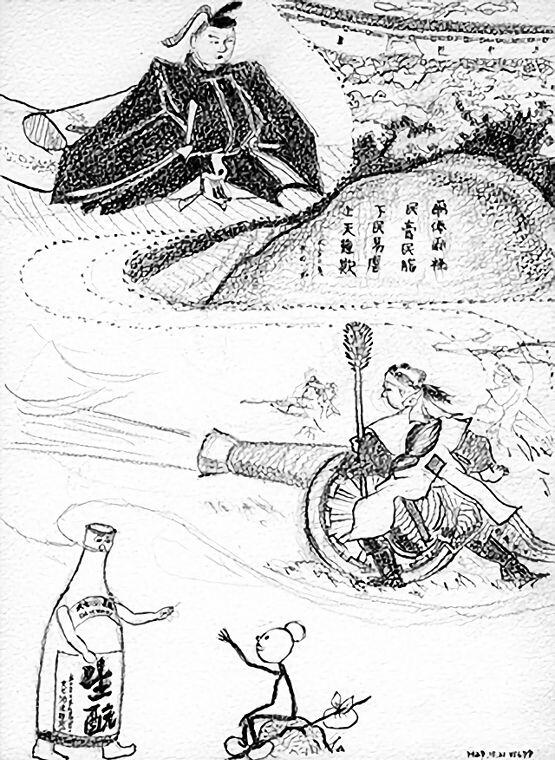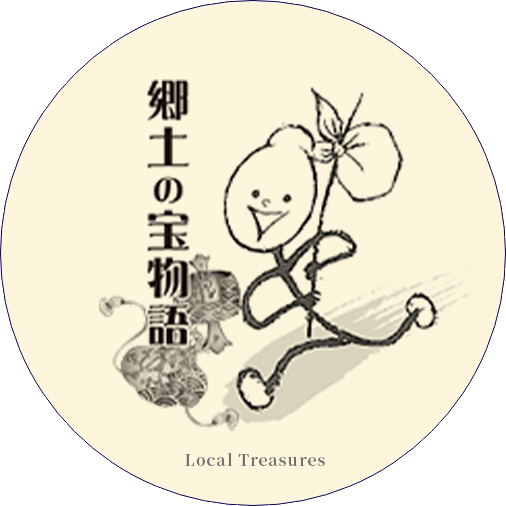| Yeast |
“Hey, Kimoto, let’s introduce our hometown Nihonmatsu to everyone! It’s packed with historical monuments.” |
| Kimoto |
“Alright, let’s go for a walk! As you know, there are many slopes and temples in castle town Nihonmatsu.” |
| Yeast |
“The town was laid out in its present form by Mitsushige Niwa (1622-1701), the grandson of famous Warring States general Nagahide Niwa (1535-1585).” |
| Kimoto |
“He enlarged the castle and built the Minowamon Gate. He also decided where the samurai ward would be and the neighborhoods of the ordinary people. He was interested in arts and sciences and invited several famous priests to Nihonmatsu. That was the time Nihonmatsu assumed its present shape.” |
| Yeast |
“The Oshu Highway runs through Honmachi and Takeda Slope and passes right in front of the Daishichi Sake Brewery. Let’s go to Kasumigajo, the castle of Nihonmatsu!” |
| - - They arrive in the vicinity of Kasumigajo Castle - - |
| Kimoto |
“This huge boulder lying at the entrance to the castle is called the Kaisekimei, it’s a national historic site. Look, there’s a text in Chinese engraved on it.” |
| Yeast |
“What’s the meaning?” |
| Kimoto |
“Something like: ‘Your salaries and stipends are the fruit of the perspiration of the people. It may be easy to oppress the people below, but you can’t deceive the gods.’ Based on the advice of the Confucian scholar Sakuhi Iwaida, the fifth Niwa lord Takahiro had the text engraved in only one night as a cautionary maxim to his retainers.” |
| Yeast |
“Sakuhi Iwaida? I believe his grave is in Taiunji temple. From the top of the hill where that temple stands, you have a great view of the Daishichi Sake Brewery!” |
| Kimoto |
“By the way, ‘Kaisekimei’ is also the name of one of Daishichi’s sakes.” |
| Yeast |
“We’ve walked along a stone wall and row of pine trees, and now a sculpture of young sword fighters comes into view: the Nihonmatsu Shonentai (Nihonmatsu Youth Corps).” |
| Kimoto |
“That bronze sculpture is the work of Kentaro Hashimoto, a Person of Cultural Merit and honorary citizen of Nihonmatsu. He has also made the statues of the komainu (guardian dogs) at the middle gate of Daishichi.” |
| Yeast |
“It’s an imposing sculpture, especially with the Minowamon Gate of the castle as background. There is also a statue of a mother worried about the fate of the Youth Corps.” |
| Kimoto |
“That was during the Boshin War (1868-69). With ages between 13 and 17, the members of the Nihonmatsu Youth Corps were even younger than the famous Byakkotai of Aizu-Wakamatsu. They decided to defend Nihonmatsu and their families, and resolutely resisted the troops of the Meiji government, but the gap in military strength was too large. In the end Nihonmatsu Castle fell and was put to the torch. Many members of the Youth Corps died a heroic death. In Dairinji Temple you’ll find the memorial stones of their leader, Jutaro Kimura, and 16 others.” |
| Yeast |
“What a sad story. At that time the Minowamon Gate also burned down, didn’t it?” |
| Kimoto |
“The Minowamon Gate had originally been built by Mitsushige. It was so named because the oak timbers used for its construction came from a sacred forest on Mt Sannoji in Minowa village. After the gate was destroyed, the citizens of Nihonmatsu requested it to be rebuilt. That was finally realized in 1982.” |
|
 |
| Yeast |
“The name Minowamon, so beloved by the citizens of Nihonmatsu, was given to one of Daishichi’s junmai daiginjo sakes. So, let’s enter the castle through the Minowamon Gate and climb to the top of the castle hill, although that’s quite a long way...” |
| Kimoto |
(puffing) “This little stream here is the Nigoda channel. Under the direction of mathematician Bunzo Isomura, it was laid out both for irrigation and the defense of the castle. Water was brought from the flank of Mt Adatara, a distance of 18 kilometers.” |
| Yeast |
“That was terrific for the Edo period! Our path gets steeper and steeper... Now we pass one of the Three Wells of Japan, the ‘Hikage no Ido.’ We’re almost at the top!” |
| Kimoto |
“I see magnificent stone ramparts rising up at the top of the hill. The stone masonry is in what is called the anozumi style of fitting unhewn stones together. That’s the honmaru, the castle’s donjon, another national historical site.” |
| Yeast |
“We’ve made it! What a grand view, we can see Nihonmatsu all around us, the whole town is lying at our feet!” |





